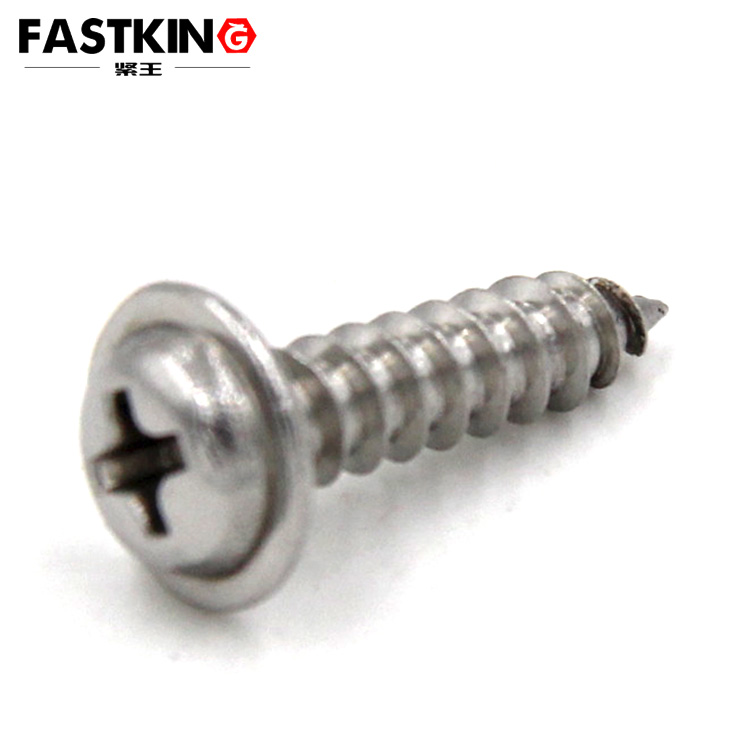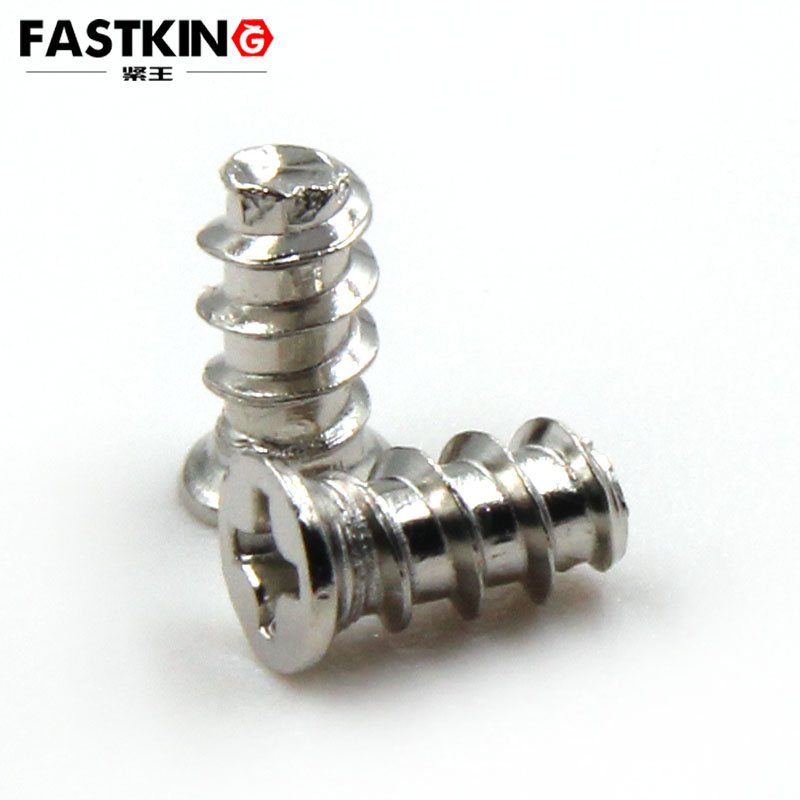- small screw,micro fastener,mini screw
- 0756-8586520
Stainless steel countersunk cross half tooth furniture appliance nails
- Product description:In scenarios such as furniture assembly and home appliance manufacturing—where both fastening effectiveness and appearance coordination are required—the stainless steel countersunk Phillips half-threa
The "countersunk head" is the key feature that distinguishes this screw from ordinary pan-head screws, and it is also the core for achieving "invisible fastening". The countersunk head adopts a conical design, which matches the pre-drilled conical counterbore on the surface of the connected component. When the screw is fully tightened, its head remains flush with the base material surface, with no protruding screw head—this design is crucial for the appearance of furniture and electrical appliances.
For example, in the jointing of solid wood wardrobe doors or the fixing of cabinet drawer slides, the countersunk head design prevents clothes or hands from being caught by protruding screw heads; in the assembly of rice cooker casings or the fixing of microwave oven control panels, the flush surface reduces dust accumulation while enhancing the product’s delicacy. Compared with pan-head screws, countersunk head screws have higher requirements for counterbore precision (usually a 90° counterbore angle, matching the screw head angle), but in return, they deliver a "no-protrusion, no-obtrusion" visual effect, perfectly aligning with the minimalist design style of modern furniture and electrical appliances.
The Choice of "Phillips Slot"
The "Phillips Slot" design endows this screw with strong assembly versatility and convenience. The Phillips slot is one of the most widely used fastener slot types globally—it can be easily paired with household manual Phillips screwdrivers as well as electric screwdrivers on automated production lines in furniture and electrical appliance factories, requiring no specialized tools.
This versatility significantly lowers the assembly threshold: ordinary consumers do not need to purchase additional special tools when assembling panel furniture at home; in mass production, the Phillips slot offers better torque transmission stability than slotted slots, minimizing "cam-out" (slippage between tool and screw) during tightening. This ensures uniform preload for each screw, reducing the risk of loosening caused by improper assembly. Data shows that in furniture assembly scenarios, the assembly efficiency of Phillips slot screws is 30% higher than that of hexagon socket screws, and the cost of compatible tools is only 1/5 of that of specialized tools, balancing efficiency and economy.
The "Half-Thread" Structure
The "Half-Thread" structure is a precise optimization tailored to the material characteristics of furniture and electrical appliances. For half-thread screws, threads are only distributed on the lower half of the shank, while the upper half is a smooth rod—this design offers two key advantages:
- Reducing Damage to Soft Materials: Furniture often uses materials with low hardness, such as solid wood, particleboard, and MDF. Full-thread screws tend to over-squeeze the base material during tightening, leading to wood cracking or panel delamination. The smooth upper half of the half-thread screw avoids additional extrusion from upper threads, making it particularly suitable for connecting thin panels (5-15mm thick).
- Enhancing Connection Stability: After the screw is driven into the base material, the smooth shank fits more tightly with the inner wall of the counterbore, reducing micro-displacements caused by vibration. For example, in the fixing of refrigerator drawer slides or wardrobe door hinges, the half-thread structure lowers the risk of loosening after long-term use, extending the product’s service life.
Some short-specification screws (e.g., length ≤10mm) adopt a full-thread design, but the core logic remains "adapting to material characteristics" to balance fastening effectiveness and base material protection.
Stainless Steel Material: Core Guarantee for Durability and Safety
The use of "stainless steel" is the core guarantee for the screw’s durability and safety. Mainstream stainless steel countersunk Phillips half-thread furniture and appliance screws on the market mostly use 304 stainless steel, while 316 stainless steel is used in high-demand scenarios (e.g., bathroom furniture, kitchen appliances):
- 304 Stainless Steel: Contains 18% chromium and 8% nickel, offering excellent corrosion resistance. It does not easily rust in humid environments (e.g., bathroom cabinets, washing machine casings) and can withstand 72-120 hours of corrosion in neutral salt spray tests, preventing base material contamination or fastening failure caused by screw rust. Meanwhile, 304 stainless steel has a tensile strength of up to 515MPa and a yield strength of ≥205MPa, which fully meets the regular load requirements of furniture and electrical appliances. For example, an M4×16 304 stainless steel screw can withstand a tensile force of over 1.5kN (equivalent to lifting a 150kg object), far exceeding the weight of furniture doors or electrical appliance casings.
- 316 Stainless Steel: For scenarios involving long-term contact with water or oil (e.g., fixing cabinets under kitchen sinks, connecting dishwasher liners), 316 stainless steel (containing 2-3% molybdenum) improves corrosion resistance by 2-3 times, further extending the screw’s service life.
Application Scenarios
The "invisible + adaptable" characteristics of this screw make it a "standard fastener" in the furniture and electrical appliance fields:
- Furniture Field: It is widely used in panel furniture jointing (e.g., connecting wardrobe side panels and top panels), fixing hardware on solid wood furniture (e.g., connecting chair armrests and legs), and reinforcing soft furniture frames (e.g., fixing sofa wooden frames and springs). The countersunk head ensures appearance, the half-thread structure protects wood, and the stainless steel material resists moisture.
- Electrical Appliance Field: It is applied in assembling casings of small home appliances (e.g., fixing soybean milk machine or coffee machine bases) and connecting internal components of large appliances (e.g., fixing air conditioner indoor unit evaporators, TV backplane screws). It is compatible with multiple materials such as plastic and metal, and meets the temperature resistance requirements of electrical appliances (304 stainless steel can withstand short-term temperatures up to 200℃, coping with local high temperatures during appliance operation).
Additionally, in the custom furniture field (e.g., on-site installation of integrated wardrobes or custom cabinets), the screw’s versatility and ease of use allow installers to avoid carrying multiple specifications of fasteners, improving on-site construction efficiency.
Usage Precautions
To fully utilize the screw’s performance, three key points should be noted:
- Counterbore Matching: Pre-drill counterbores according to the screw head specifications (e.g., an M4 screw requires a 6mm diameter, 90° angle counterbore). An overly deep counterbore will prevent the screw head from fitting the base material, while an overly shallow one will fail to achieve a flush effect. It is recommended to use a dedicated counterbore drill for precision.
- Torque Control: Adjust the tightening force based on the base material hardness. For example, when tightening an M4×16 screw on solid wood, the manual torque should be approximately 1.2-1.8N·m. Over-tightening may cause base material cracking, while insufficient torque may lead to loosening. For home use, "hand feel judgment" (no obvious wobble of the screwdriver after tightening) is acceptable; for factory use, a torque driver is recommended for control.
- Scenario Adaptation: Prioritize 304 or 316 stainless steel for humid environments such as bathrooms and kitchens, avoiding carbon steel galvanized screws (which easily rust); when connecting metal base materials (e.g., aluminum alloy casings of electrical appliances), apply a small amount of anti-rust oil to the screw threads to further enhance corrosion resistance.
As an "invisible aesthetic expert" in the furniture and electrical appliance fastening field, the stainless steel countersunk Phillips half-thread furniture and appliance screw deeply integrates "appearance requirements", "base material protection", "assembly convenience", and "durability". It not only solves the pain points of traditional screws—"obtrusive appearance and easy base material damage"—but also meets the pursuit of "delicacy and reliability" in modern furniture and electrical appliances. With the development of custom furniture and smart home appliances, requirements for fastener adaptability and aesthetics will further increase. Relying on its advantages of "multi-scenario adaptation and high cost-effectiveness", this screw is expected to become a "basic fastener" in more fields, building an "invisible reliable defense" for home life and electrical appliance use.








